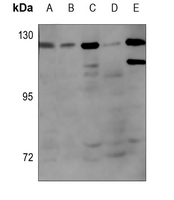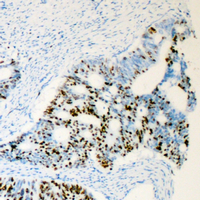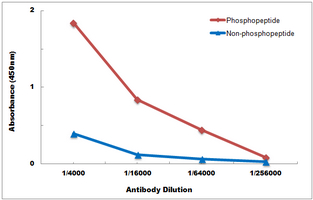产品描述:Rabbit polyclonal antibody to Androgen Receptor (Phospho-S650)免疫原:KLH-conjugated synthetic phosphopeptide corresponding to residues surrounding S650 of human Androgen Receptor protein. The exact sequence is proprietary.纯化方式:The antibody was purified by immunogen affinity chromatography.克隆类型:Polyclonal产品形式:Liquid in 0.42% Potassium phosphate, 0.87% Sodium chloride, pH 7.3, 30% glycerol, and 0.01% sodium azide.稀释比:WB (1/500 - 1/1000), IH (1/100 - 1/500)基因名称:AR相关名称:DHTR; NR3C4; Androgen receptor; Dihydrotestosterone receptor; Nuclear receptor subfamily 3 group C member 4
基因编号(人):
367;
基因编号(小鼠):
11835;
基因编号(大鼠):
24208;
蛋白编号(人):
P10275;
蛋白编号(小鼠):
P19091;
蛋白编号(大鼠):
P15207;
储存效期:Shipped at 4°C. Upon delivery aliquot and store at -20°C for one year. Avoid freeze/thaw cycles.
-
 Western blot analysis of Androgen Receptor (Phospho-S650) expression in H1688 (A), mouse liver (B), mouse kidney (C), rat liver (D), rat kidney (E) whole cell lysates. (Predicted band size: 99; 110 kD; Observed band size: 120 kD)
Western blot analysis of Androgen Receptor (Phospho-S650) expression in H1688 (A), mouse liver (B), mouse kidney (C), rat liver (D), rat kidney (E) whole cell lysates. (Predicted band size: 99; 110 kD; Observed band size: 120 kD) -
 Immunohistochemical analysis of Androgen Receptor (Phospho-S650) staining in human prostate cancer formalin fixed paraffin embedded tissue section. The section was pre-treated using heat mediated antigen retrieval with sodium citrate buffer (pH 6.0). The section was then incubated with the antibody at room temperature and detected using an HRP conjugated compact polymer system. DAB was used as the chromogen. The section was then counterstained with haematoxylin and mounted with DPX.
Immunohistochemical analysis of Androgen Receptor (Phospho-S650) staining in human prostate cancer formalin fixed paraffin embedded tissue section. The section was pre-treated using heat mediated antigen retrieval with sodium citrate buffer (pH 6.0). The section was then incubated with the antibody at room temperature and detected using an HRP conjugated compact polymer system. DAB was used as the chromogen. The section was then counterstained with haematoxylin and mounted with DPX. -
 Direct ELISA antibody dose-response curve using Anti-Androgen Receptor (Phospho-S650) Antibody. Antigen (Phosphopeptide and non-phosphopeptide) concentration is 5 ug/ml. Goat Anti-Rabbit IgG (H&L) - HRP was used as the secondary antibody, and signal was developed by TMB substrate.
Direct ELISA antibody dose-response curve using Anti-Androgen Receptor (Phospho-S650) Antibody. Antigen (Phosphopeptide and non-phosphopeptide) concentration is 5 ug/ml. Goat Anti-Rabbit IgG (H&L) - HRP was used as the secondary antibody, and signal was developed by TMB substrate.
Cutting edge: Depletion of Foxp3+ cells leads to induction of autoimmunity by specific ablation of regulatory T cells in genetically targeted mice
Discovery and mechanistic characterization of a novel selective nuclear androgen receptor exporter for the treatment of prostate cancer
Identification of androgen receptor phosphorylation in the primate ovary in vivo


 说明书
说明书 MSDS
MSDS